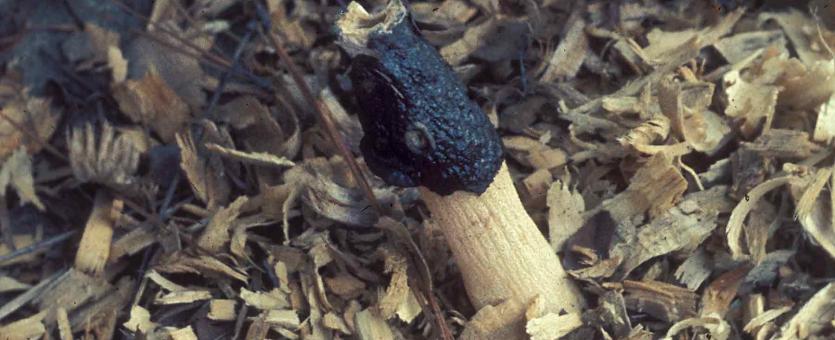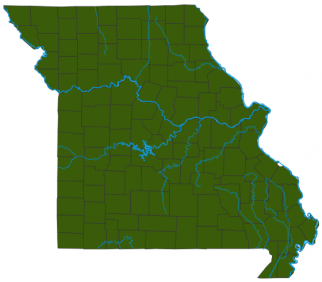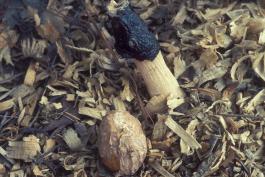
Long, whitish column with a greenish, smelly slime covering the top; whitish or pinkish cup around the base. Grows on wood debris, rotted stumps, and sawdust, and in deciduous woods. August–October. Fruiting body a cylindrical column; whitish; top covered with a thick, slimy, greenish brown, unpleasant smelling, conical spore mass, with a small opening at the tip; base enclosed in a whitish to pinkish saclike cup that is attached to the ground by white, cordlike tissue. Spores greenish brown. Spores magnified are elliptical, smooth, colorless. This is a weird-looking mushroom, and once you see (and smell) it, you’ll always remember it.
Lookalikes: The common stinkhorn (Phallus impudicus) is similar but with a deeply pitted head.
Fruiting body height: 1–2 inches; height: 4–9 inches.

Statewide.
Habitat and Conservation
Singly to clustered on wood debris, rotted stumps, and sawdust, and in deciduous woods. Common on mulch. The strong odor of stinkhorns can be smelled from several feet away. This odor comes from the sticky spore mass on the top of the cap, which flies eat and walk on and then disperse.
Status
Considered a good edible mushroom, with caution. The immature stage of this stinkhorn is a white, rubbery “egg” or “button” about 2 inches wide. In this stage, it does not have a foul odor and is known to be edible and quite good. However, if you want to try eating stinkhorn eggs, have an expert identify them, since the deadly amanitas also have an immature “egg” stage.
Life Cycle
This species spends most of its life as a network of fungal cells (mycelium) that penetrates wood debris, digesting and decaying organic materials. When ready to reproduce, the mycelium develops the “stinkhorn” aboveground. The top of the stalk is covered with a foul, greenish slime that attracts flies. The slime contains the spores, and the flies distribute the spores wherever they go. The spores can grow into new mycelia elsewhere.
Human Connections
Fungi can be strikingly beautiful — or breathtakingly strange! Discovering fungi can bring out our innate capacity for awe and wonder. We can choose to view them with disgust, amusement, or plain curiosity.
Ecosystem Connections
Fungi are vitally important for a healthy ecosystem. This fungus feeds on decaying wood, decomposing the tough materials wood is made of. This cleans the forest and helps nutrients to cycle back into the soil.


Mushrooms are a lot like plants, but they lack chlorophyll and have to take nutrients from other materials. Mushrooms are neither plants nor animals. They are in a different kingdom — the fungi. Fungi include the familiar mushroom-forming species, plus the yeasts, molds, smuts, and rusts.
Always be cautious when eating edible mushrooms. Be absolutely sure of the ID, and only eat a small amount the first time you try it to avoid a reaction..





















